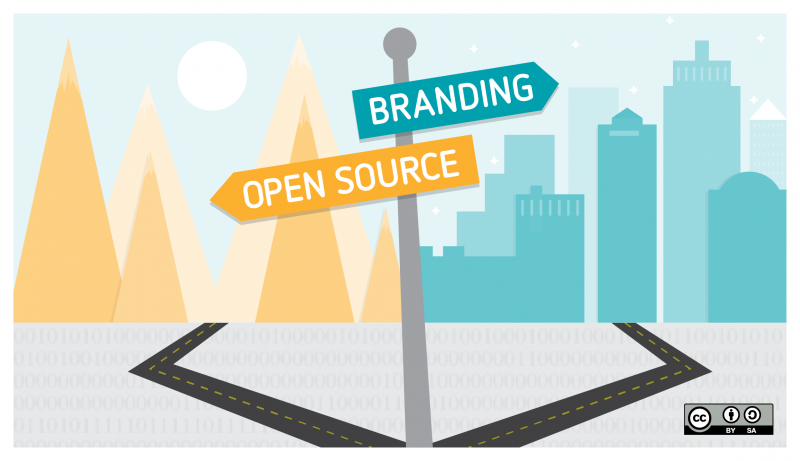When it comes to developing a new open source software project, most developers don't spend a lot of time thinking about brand strategy. After all, a great idea, solid code, and a passionate community are what really matter when you're getting a project underway.
The first brand strategy decision most project owners make is choosing a name for their project. For many, naming might consist of perusing a list of science fiction terms, looking for a name that hasn't already been claimed by another project, or taking an inside joke and adding a few extra vowels or consonants here and there to make up a new name with an available URL.
But beyond the basics, what should someone beginning a new open source project be thinking about when it comes to how they name their baby?
Over the past 15 years, I've had the opportunity to work on brand strategy for a variety of open source technology companies. During my 10 years at Red Hat, I worked on lots of complicated open source branding issues. In my current role at the branding firm New Kind, we've worked with several other leading open source companies like Ansible, NGINX, and Continuum Analytics to develop brand strategies positioning them for future growth.
I'd like to share, in a series of posts, what I've learned about the intersection of branding and open source. My goal is to help people starting new open source projects gain a deeper understanding of brand strategies they could be considering, while also helping people already immersed in open source projects or companies understand some basic branding concepts they can employ in their work.
Today, we start with some simple tips about how to research and choose an open source project name.
Find a brand space you can own
One of the first things to consider as you name your open source project is your long-term goal for the project. If you are like many people starting up new projects, you may have the dream of your open source project eventually becoming a product you can sell, or even the basis of a company built around servicing and supporting the project code. The fact is, if you want to create valuable equity in your brand name that positions you for the future, you must start by choosing a brand name you can own.
One mistake I’ve seen made regularly in the open source world is people picking a name for their open source project they have no hope of successfully protecting with a registered trademark. Usually the name is already in use by another project or organization, or it is a common word that will be difficult or impossible to protect.
Before choosing your final name, consider putting it through its paces using a simple, informal vetting process. While this won’t necessarily guarantee your name is free and clear, it will at least help you quickly eliminate names that you have no hope of owning.
Search the trademark database
Start by testing your name against the US Patent and Trademark Office trademark database. Test not only the exact spelling of your name, but also similar spellings that might be confused with your chosen brand name.
If you see another registered trademark with your exact name, that doesn’t necessarily mean you should throw it out. While it is important to make a note of any brand in any industry that uses the same name, you’ll want to look extra carefully for brands in the technology industry (you can usually get a hint about what category the trademark registration covers by examining the Goods and Services category on the trademark page). If you see trademarks in very similar or related categories to what your project will be doing, probably best to go ahead and move on to your next name choice.
Search for others already using your name
If your name seems fairly free and clear to use from searching the trademark database, the next step is to do some basic Google searches (and probably searches at other relevant sites like GitHub too) looking for other organizations or projects using the same or similar names. Remember that the US Patent and Trademark Office only catalogs brands that have registered for trademark protection in the United States, so there may be organizations using your chosen brand name elsewhere in the world, or it may just not have been registered yet (which doesn’t mean the name is fair game, because even unregistered trademarks still have significant protections).
Start by searching for your chosen brand name in Google, on its own. This will be especially valuable if it is a made-up word (what trademark lawyer-types would call a "fanciful" name). Does anything come up? Also try searching for some similar variants of your possible name. Are there closely named brands in the technology industry or elsewhere? If after doing this, if you still feel like the space is fairly clear, or at least you don't see clearly similar names in the technology industry, you may also want to do additional, more specific searches.
For example, you’d be surprised at how many brand names have already been claimed by other open source projects. A search as simple as "YOURBRAND open source" is a great place to start, but then also try "YOURBRAND software," "YOURBRAND technology," and "YOURBRAND company" just to cover additional territory. If your project covers a specific type of technology like cloud or containers or microservices, it is worth searching for it with descriptive terms like these as well.
Seek out the perfect Web domain
Finally, once you feel more confident that your brand namespace is potentially ownable, head on over to your favorite web domain registrar and start checking out domain names. What domains are available that are simple, memorable, and hopefully inexpensive to buy?
If the obvious .com and .org domains are not available, make sure they are not being used by websites or companies that will cause confusion or potentially damage the future value of your brand. For example, we had one experience where our preferred domain was already in use by an especially super-creepy porn site. In this case, we were eventually able to procure the domain and remove the offending domain, but this may not always be possible, and even when it is, it may not be an inexpensive problem to solve.
Visit the FOSSmarks.org website
If you are just beginning the naming process, and want some additional information on how to navigate the legal aspects of the naming process, FOSSmarks.org is a fantastic resource. It was started by a group of knowledgeable intellectual property attorneys with deep experience in open source. This site has valuable information explaining the basics of trademark law, some of the important legal considerations to keep in mind when choosing a name, how to register a trademark, and even how to design and enforce a trademark policy.
Concluding thoughts
Hopefully, for many of you, most of the basic research steps above are intuitive and just serve as a simple reminder of what you are already doing when you develop a new project name. But based on my experience, it is clear to me that many people skip one or more of these steps.
It is worth mentioning that there is no substitute, when money allows, for bringing in an experienced intellectual property lawyer to formally research and give you a legal analysis of the risks associated with your chosen name, then eventually to help you apply for a trademark on the name.
But by following these simple steps first, you may be able to reduce the expense associated with this process and eliminate or shortcut some costly dead ends.






1 Comment